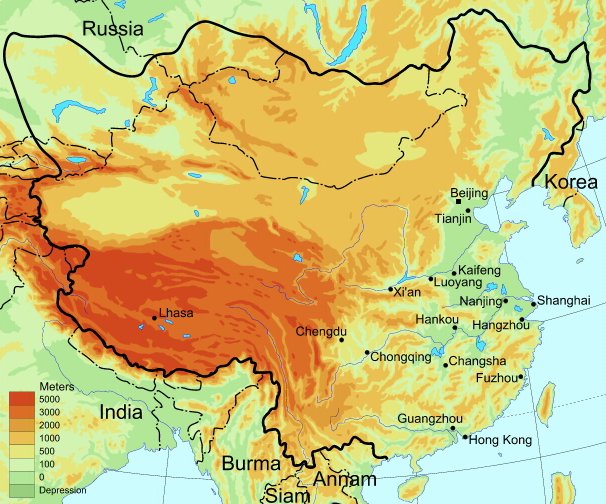
Ching Dynasty Territory |
Ching Dynasty (1644 - 1911)

Ching Dynasty Territory |
When
the Mam people unified China and established the Ching Dynasty, they respected
the culture of the Han people. So in the early Ching Dynasty, the influence on
calligraphy styles by the late Ming Dynasty officers like Wang Duo (
王
鐸 ) and Fu San (
傅
山 ) was prevalent.
In
the early Ching Dynasty, Emperor Kun Shi ( 康 熙
) favored Dong
Chi-Tsun's calligraphy and many people studied Dong Chi-Tsun's calligraphy.
At the same time, there were people against Dong’s work because of his lack of
masculine strength. Soon more
people realized that Dong's
calligraphy was not at top level in history and deep in spirits. They could
never become great calligraphers even though they did as great as Dong did.
Later, they switched to Zhao Meng-Fu who was
renowned in the Yuan Dynasty but was also demeaned by some serious
calligraphers. Nevertheless, the early Ching Dynasty’s calligraphy environment was
deeply influenced by Zao Meng-Fu, Dong Chi-Tsun, Su Shu, and Huang Ting-Jian at
large.
During
the regime of Yong Zheng ( 雍 正 ) and Chian Long ( 乾 隆
) (the third and fourth emperors of the Ching Dynasty), “Wen Zi Yu
文 字 獄” caused very
serious political accusations for writers. (“Wen Zi” means characters or
writings and “Yu” means imprisonment.) “Wen Zi Yu” was the law
forbidding people to write any articles that are politically incorrect or implied.
Many people suffered death by writing words that were not even related to
politics. As a result, many scholars began archeological research to avoid being
wrongfully accused.
During Dao Guan’s ( 道 光 ) reign, more calligraphy from earlier dynasties on tablets were discovered. People gradually began to study and emulate calligraphy on tablets rather on papers, leading to the revolution and resurrection of Zuan and Li Styles. Thus the revolution of “Bei Shuae 碑 學” revitalized Chinese calligraphy in the Ching Dynasty. (“Bei” means monuments or tablets and “Shuae” means learning or school.”) This revolution also enriched Chinese seal making in the Ching Dynasty while many masters of seal carving were also top Zuan Shu specialists or exponents.
·
Wang Duo
王 鐸 (1592-1652):
He lived from the end of the Ming Dynasty to the early Ching Dynasty. He had a
special point of view for Wang Hsi-Chih’s calligraphy.
· Chu Da 朱 耷 (1625-1705): He was nicknamed “Eight Big Mountain Man ( 八 大 山 人 ).” (Actually he was the only one man. There was nobody else!) His painting and calligraphy showed a transcendental state of Zen tranquility.
· Liu Yong 劉 墉 (1719-1804): The critics said that his calligraphy was mild in appearance yet full of condensed force internally, that is, he had reached the level of “needle inside cotton.” He was widely considered the best calligrapher in the Ching Dynasty. He emulated many masterpieces. He started learning Wei Bei after age 70.
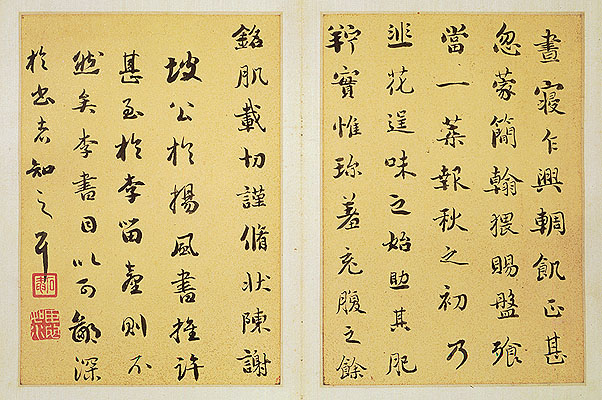
·
Wong Fun-Gong 翁 方 綱 (1732-1818):
His methodology in calligraphy was strict and he criticized other calligraphers. He specialized in
both Be & Te schools ( 碑 學 & 帖 學
).
· Deng Shu-Ru 鄧石如 (1743-1805): He was good at all five major styles, especially in Zuan & Li Styles. He was considered the number one calligrapher in Zuan Style after Lee Yang-Bing ( 李陽冰 ) of the Tang Dynasty. He traveled during most of his lifetime to make friends. He was also a top martial arts fighter. His fifth-generation descendent, Deng Yi-Zhe ( 鄧以蜇, 1892-1973) published many excellent essays about aesthetics on Chinese philosophy, calligraphy, and painting and other arts.
· Yi Bin-So 伊 秉 綬 (1754-1815): He was peered with Deng Thu-Ru for his Li Style. He studied Zen meditation and philosophy. His works showed a high level of serenity and strength.
·
Ho Shao-Ji 何 紹 基 (1799-1873): He was a learned scholar and historian. As a
calligrapher, he practiced emulation of masterpieces diligently. His strokes
have a free appearance. The viewers can imagine him rotating his brush in his
hand during writing.
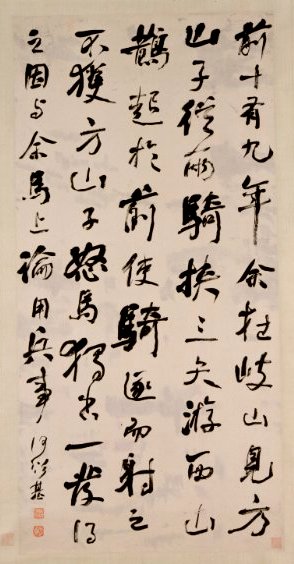
· Wu Da-Cheng 吳 大 澂 (1839-1902): Famous linguist and exponent of Zuan Shu.
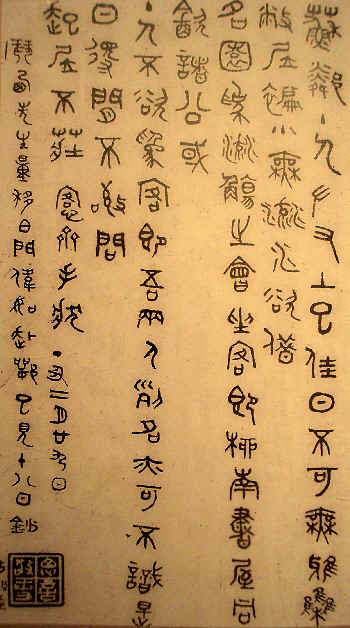
· Yang Yi-Son 楊 沂 孫 (1812-1881): Zuan specialist. He wrote articles about Zuan Shu characters.
· Wu Run-Chih 吳 讓 之 (1799-1870). He was a top Zuan Shu stylist and was influenced by Deng Shu-Ru. He was also good at seal carving and painting.
· Zhao Chih-Chian 趙 之 謙 (1829-1884): He was famous for inheriting Wei Bei strokes into his Zuan and Li Styles. He was also good at painting and seal engraving. Most scholars consider his work shows feminine characteristics and lacks masculine power.
· Wu Tsun-Shuo 吳 昌 碩 (1844-1927): He was good at Zuan Shu, painting & seal making. He was a president of the Xi Leng Seals Society ( 西冷印社). He was famous for his emulation of “Stone Drum Inscriptions.”
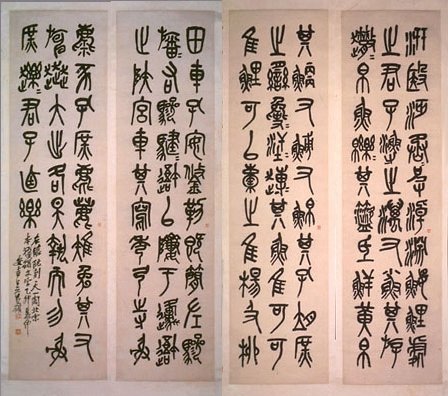
· Pu Hsin-Yu 溥儒 (1895-1963): Born into the imperial family of the Ching Dynasty, Pu Hsin-Yu was good at literature, poetry, calligraphy, and especially painting. His Kai Shu calligraphy was considered number one in the last 500 years of history by many scholars. He lived and taught in Taipei, Taiwan in his later years.
![]()
For
more details of each style’s development, please refer to the respective Zuan,
Li, Tsao, Hsin, and Kai Styles.